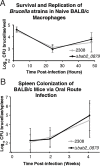Characterizing the transport and utilization of the neurotransmitter GABA in the bacterial pathogen Brucella abortus
- PMID: 32845904
- PMCID: PMC7449393
- DOI: 10.1371/journal.pone.0237371
Characterizing the transport and utilization of the neurotransmitter GABA in the bacterial pathogen Brucella abortus
Abstract
The neurotransmitter gamma-aminobutyric acid (GABA) is the most abundant inhibitory neurotransmitter in the human brain; however, it is becoming more evident that this non-proteinogenic amino acid plays multiple physiological roles in biology. In the present study, the transport and function of GABA is studied in the highly infectious intracellular bacterium Brucella abortus. The data show that 3H-GABA is imported by B. abortus under nutrient limiting conditions and that the small RNAs AbcR1 and AbcR2 negatively regulate this transport. A specific transport system, gts, is responsible for the transport of GABA as determined by measuring 3H-GABA transport in isogenic deletion strains of known AbcR1/2 regulatory targets; however, this locus is unnecessary for Brucella infection in BALB/c mice. Similar assays revealed that 3H-GABA transport is uninhibited by the 20 standard proteinogenic amino acids, representing preference for the transport of 3H-GABA. Metabolic studies did not show any potential metabolic utilization of GABA by B. abortus as a carbon or nitrogen source, and RNA sequencing analysis revealed limited transcriptional differences between B. abortus 2308 with or without exposure to GABA. While this study provides evidence for GABA transport by B. abortus, questions remain as to why and when this transport is utilized during Brucella pathogenesis.
Conflict of interest statement
The authors have declared that no competing interests exist.
Figures







Similar articles
-
A 6-Nucleotide Regulatory Motif within the AbcR Small RNAs of Brucella abortus Mediates Host-Pathogen Interactions.mBio. 2017 Jun 6;8(3):e00473-17. doi: 10.1128/mBio.00473-17. mBio. 2017. PMID: 28588127 Free PMC article.
-
Characterization of Three Small Proteins in Brucella abortus Linked to Fucose Utilization.J Bacteriol. 2018 Aug 24;200(18):e00127-18. doi: 10.1128/JB.00127-18. Print 2018 Sep 15. J Bacteriol. 2018. PMID: 29967118 Free PMC article.
-
Identification of two small regulatory RNAs linked to virulence in Brucella abortus 2308.Mol Microbiol. 2012 Jul;85(2):345-60. doi: 10.1111/j.1365-2958.2012.08117.x. Epub 2012 Jun 12. Mol Microbiol. 2012. PMID: 22690807 Free PMC article.
-
Roles of glutamine in neurotransmission.Neuron Glia Biol. 2010 Nov;6(4):263-76. doi: 10.1017/S1740925X11000093. Epub 2011 Oct 21. Neuron Glia Biol. 2010. PMID: 22018046 Review.
-
Gamma-Aminobutyric Acid Signaling in Damage Response, Metabolism, and Disease.Int J Mol Sci. 2023 Feb 26;24(5):4584. doi: 10.3390/ijms24054584. Int J Mol Sci. 2023. PMID: 36902014 Free PMC article. Review.
Cited by
-
Metabolomic analysis of murine tissues infected with Brucella melitensis.PLoS One. 2025 Jan 27;20(1):e0314672. doi: 10.1371/journal.pone.0314672. eCollection 2025. PLoS One. 2025. PMID: 39869554 Free PMC article.
-
A comprehensive review of small regulatory RNAs in Brucella spp.Front Vet Sci. 2022 Dec 1;9:1026220. doi: 10.3389/fvets.2022.1026220. eCollection 2022. Front Vet Sci. 2022. PMID: 36532353 Free PMC article. Review.
References
Publication types
MeSH terms
Substances
Grants and funding
LinkOut - more resources
Full Text Sources
Molecular Biology Databases

